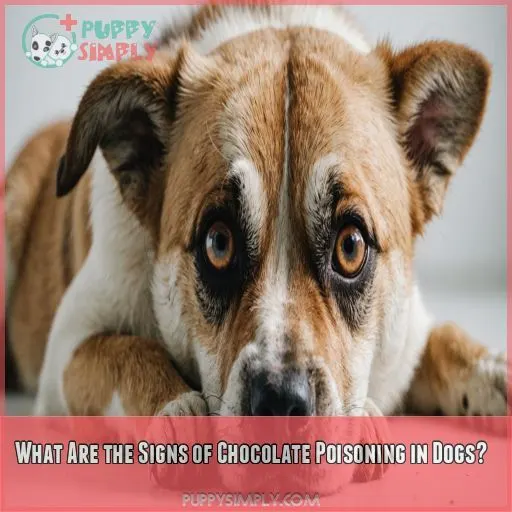This site is supported by our readers. We may earn a commission, at no cost to you, if you purchase through links.

Sorry to be the bearer of bad news, but it’s best to keep those creamy treats out of reach.
White chocolate contains theobromine, a toxin that dogs can’t metabolize, which can lead to vomiting, diarrhea, and an abnormal heart rate – even in small amounts.
Can dogs eat white chocolate? Unfortunately, it’s a solid no. The risks just aren’t worth it.
But don’t worry, we’ve got the scoop on safe alternatives and expert advice on what to do if your dog accidentally gets their paws on some white chocolate.
Table Of Contents
- Key Takeaways
- Is White Chocolate Bad for Dogs?
- Can Dogs Eat White Chocolate Safely?
- What Are the Signs of Chocolate Poisoning in Dogs?
- What to Do if Your Dog Eats White Chocolate
- How to Prevent Your Dog From Eating Chocolate
- Type of Chocolate and Dogs
- Can Dogs Eat White Chocolate Treats?
- Dog-Safe Chocolate Alternatives
- What to Expect at the Vet’s Office
- Frequently Asked Questions (FAQs)
- What happens if a dog eats white chocolate?
- How much white chocolate is too much for a dog?
- Is dark chocolate worse than white chocolate for dogs?
- Can dogs eat a little but of chocolate?
- Can white chocolate cause long-term damage to my dogs health?
- How does a dogs age affect white chocolate toxicity levels?
- Are certain breeds more susceptible to white chocolate poisoning?
- Can dogs develop an allergy to white chocolate over time?
- Is it safe to give dogs small amounts of white chocolate regularly?
- Conclusion
Key Takeaways
- You’ll want to keep those creamy white chocolate treats out of reach – even small amounts can be toxic to your furry friend, causing vomiting, diarrhea, and an abnormal heart rate due to theobromine poisoning.
- Don’t panic if your dog sneaks a tiny bit of white chocolate, but do act quickly – monitor for signs of poisoning, and rush to the vet if symptoms appear, as prompt action is key to preventing long-term damage.
- When it comes to chocolate, the darker it gets, the more toxic it becomes for your dog, so while white chocolate is still off-limits, its lower theobromine content makes it slightly less hazardous than dark chocolate.
- Instead of risking your dog’s health with white chocolate, consider dog-friendly baking with healthy ingredients like carrots, apples, and green beans, or opt for commercial alternatives made with wholesome ingredients – your furry friend will thank you for the tasty, safe snacks.
Is White Chocolate Bad for Dogs?
You’re probably wondering if it’s safe to share your white chocolate treats with your furry friend – after all, who can resist those puppy eyes? Unfortunately, white chocolate is indeed bad for dogs, and you need to understand why, so you can keep your canine companion safe and healthy.
Toxic Effects of Theobromine
The sweet temptation of white chocolate! But beware, it’s not as harmless as it seems. Theobromine, a sneaky toxin, lurks within, posing a threat to your furry friend. Dogs can’t metabolize theobromine, leading to toxic build-up. Even small amounts can cause chaos, with symptoms like vomiting, diarrhea, and an abnormal heart rate.
Digestive Issues and Stomach Upset
So, your furry friend got into some white chocolate? Now you’re worried about digestive issues and stomach upset. You’re right to be concerned! White chocolate can cause:
- Vomiting
- Diarrhea
- Increased thirst
- Abdominal pain
- Restlessness
These symptoms can be uncomfortable for your dog and may lead to more serious complications if left untreated.
Risk of Pancreatitis and Other Complications
Eating white chocolate can put your furry friend at risk of pancreatitis, a painful and potentially life-threatening condition. The high sugar and fat content in white chocolate can cause digestive problems, especially in smaller dogs. Use a chocolate toxicity calculator to determine the risks based on your dog’s size and weight.
Can Dogs Eat White Chocolate Safely?
You’re probably wondering if it’s safe to sneak your furry friend a piece of white chocolate – after all, it’s not as toxic as dark or milk chocolate, right? Unfortunately, while the risk is lower, white chocolate still poses a threat to your dog’s health, and you should understand the factors that affect its toxicity levels.
Factors Affecting Toxicity Levels
With white chocolate toxicity in dogs, several factors come into play. Your dog’s weight, age, and health conditions all impact the severity of theobromine risks. The type of chocolate and amount consumed also matter. Keep in mind that even small amounts can be toxic, so it’s always best to err on the side of caution.
Safe Amounts of White Chocolate for Dogs
Here’s the scoop: there’s no truly "safe" amount of white chocolate for dogs, as even small amounts can cause issues. However, if your furry friend has snatched a tiny bit, don’t panic! Consider their dog weight and size. Still, it’s super important to keep white chocolate out of reach to avoid any potential harm.
Dangers of Regular Consumption
Consuming white chocolate regularly can lead to long-term health complications in dogs, including liver damage, weight gain, and digestive problems. Don’t make it a habit! Even small amounts can cause theobromine poisoning over time. Keep those tasty treats out of reach to make sure your furry friend stays safe and healthy.
What Are the Signs of Chocolate Poisoning in Dogs?
If your furry friend has gotten their paws on some white chocolate, you’ll want to know what signs of chocolate poisoning to look out for. Common symptoms can range from mild to severe and include vomiting, diarrhea, restlessness, and an increased heart rate, so it’s important to monitor your dog closely and seek veterinary care if you suspect poisoning.
Common Symptoms of Chocolate Toxicity
How quickly can you spot the warning signs? Common symptoms of chocolate toxicity in dogs include vomiting, diarrhea, tremors, restlessness, and an abnormal heart rate. If your furry friend has ingested white chocolate, monitor them closely for these red flags. The sooner you act, the better the chances of treating theobromine poisoning effectively.
Severe Symptoms and Emergency Care
If your dog is experiencing severe symptoms like seizures, collapse, or difficulty breathing, don’t wait – rush them to the emergency vet. Keep the Pet Poison Helpline handy (855-764-7661). Treatment may involve activated charcoal, seizure prevention, and ICU care. Recovery time varies, but prompt action is key to preventing long-term damage.
Importance of Prompt Veterinary Intervention
When your dog ingests white chocolate, every minute counts. Prompt veterinary intervention is essential to prevent long-term damage or even death. Don’t wait for symptoms to worsen – rush to the vet!
- Your dog’s life depends on swift action
- Delaying treatment can lead to fatal consequences
- Quick response is key to a happy, healthy pup
What to Do if Your Dog Eats White Chocolate
If your dog gets into white chocolate, don’t panic – but do act quickly. Your first steps will be to monitor for signs of poisoning, possibly induce vomiting or administer activated charcoal, and seek emergency veterinary care if things take a turn for the worse.
Monitoring for Signs of Poisoning
If your furry friend has gobbled up white chocolate, stay calm and monitor them closely. Watch for signs of poisoning like vomiting, diarrhea, restlessness, tremors, or seizures. Keep an eye on their behavior and note any changes. If symptoms worsen, don’t hesitate to seek veterinary care – your pup’s safety is paramount!
Inducing Vomiting and Activated Charcoal
Your furry friend’s got a white chocolate mishap? Stay calm! If your vet recommends inducing vomiting, don’t try it at home. Here are some key points to keep in mind:
- Vomiting risks: Done incorrectly, it can cause more harm.
- Charcoal effectiveness: Activated charcoal can help absorb toxins.
- Timing of treatment: Act fast, as time is essential.
- Charcoal dosage: Only your vet can provide the correct amount.
Seeking Emergency Veterinary Care
If your dog eats white chocolate, don’t panic! After inducing vomiting and administering activated charcoal, rush to the vet for emergency care. Look out for severe symptoms like seizures, tremors, or difficulty breathing. Be prepared for an urgent vet visit, which may cost between $500 to $1,000 or more.
How to Prevent Your Dog From Eating Chocolate
To keep your furry friend safe, you’ll want to take a few simple precautions to prevent them from getting their paws on chocolate. By keeping chocolate out of reach, teaching your dog to "leave it," and crate training, you can avoid the stress and danger of chocolate poisoning and enjoy a peaceful coexistence with your sweet-toothed pup.
Keeping Chocolate Out of Reach
To keep chocolate out of reach, establish a safe and dog-proofed home. Here are some practical tips:
- Store chocolate in a high cabinet or pantry.
- Use child-safety locks on cabinets and drawers.
- Keep countertops and tables clear of tempting treats.
- Seal trash cans tightly.
- Consider crate training to limit access.
Teaching Your Dog to Leave It
Now that you’ve kept chocolate out of reach, it’s time to teach your dog to ‘leave it.’ This command is a lifesaver regarding chocolate temptation. Start with treats, then move to toys and other objects. Be patient and consistent, and remember to reward good behavior – your dog’s safety depends on it!
Crate Training and Safe Alternatives
While crate training may seem unrelated to chocolate safety, it’s a game-changer! By crate training your dog, you’re preventing them from getting into chocolate, but also going a step further and teaching them to relax in a safe space. Here are some benefits:
- Reduces separation anxiety
- Prevents destructive behavior
- Creates a safe zone
- Helps with housetraining
Type of Chocolate and Dogs
Regarding your furry friend’s sweet tooth, not all chocolates are created equal – some are far more toxic than others. Let’s break down the different types of chocolate, from the most toxic cocoa powder to white chocolate, so you can keep your pup safe and happy.
Toxicity Levels of Different Chocolates
In the context of chocolate, it’s not just about white chocolate. You need to know the toxicity levels of different chocolates to keep your furry friend safe. Here’s a breakdown:
| Chocolate Type | Theobromine per oz |
|---|---|
| Cocoa Powder | 35-40 mg |
| Unsweetened Baker’s | 25-30 mg |
| Semisweet | 15-20 mg |
| Dark Chocolate | 10-15 mg |
| Milk Chocolate | 5-10 mg |
Cocoa Powder and Baking Chocolate Risks
You’re aware of the varying toxicity levels of different chocolates, but let’s get specific about cocoa powder and baking chocolate. These two are the most toxic to dogs due to their high theobromine content.
- A teaspoon of cocoa powder can be toxic to a small dog
- Baking chocolate contains more theobromine than milk chocolate
- Ingesting cocoa powder can cause vomiting, diarrhea, and seizures
- Baking with chocolate requires extra precautions to guarantee your dog’s safety
Dark Chocolate Vs. White Chocolate
Regarding chocolate, the darker it gets, the more toxic it becomes for your furry friend. Dark chocolate contains more theobromine than white chocolate, making it a bigger no-no for dogs. While white chocolate is still off-limits, its lower theobromine content makes it slightly less hazardous than dark chocolate.
Can Dogs Eat White Chocolate Treats?
It’s important to remember that even small amounts of white chocolate can be toxic to your furry friend. Whether it’s white chocolate chips, ice cream, or macadamia nut-filled goodies, these seemingly harmless indulgences can quickly turn into a veterinary emergency if your dog gets their paws on them.
White Chocolate Chips and Ice Cream Risks
If you’re looking for white chocolate treats, beware of hidden dangers. White chocolate chips and ice cream can be toxic to dogs due to their high sugar and fat content. Opt for safe dessert options like carob-based treats or yogurt drops instead. Your furry friend’s sweet tooth will thank you.
Macadamia Nut and Pretzel Dangers
If you’re giving white chocolate treats, beware of macadamia nuts and pretzels! Macadamia nuts are toxic to dogs, causing weakness, depression, and tremors. Pretzels, even without chocolate, are high in salt and can be deadly. Keep these snacks out of reach, and opt for dog-safe alternatives to avoid a world of trouble.
Safe Alternatives for Dog Treats
For a sweet treat, consider dog-friendly baking with healthy ingredients like carrots, apples, and green beans. You can also try homemade treat recipes or fruit and veggie treats. If you’re short on time, look for commercial alternatives made with wholesome ingredients. Your furry friend will thank you for the tasty, safe snacks!
Dog-Safe Chocolate Alternatives
You’re probably thinking, "No chocolate for my furry friend, but what’s a good alternative?" Fortunately, there are some yummy and safe options for your dog, like carob, a plant-based substitute that’s perfect for satisfying their sweet tooth without the risks associated with chocolate.
Carob as a Safe Alternative
The eternal quest for a pup-friendly chocolate alternative is a common problem for dog owners.
Carob is a safe, non-toxic substitute that’s perfect for satisfying your dog’s sweet tooth.
Unlike chocolate, carob doesn’t contain theobromine, making it a great option for treats. You can look for reputable brands that offer carob-based goodies, or try whipping up your own carob recipes at home.
However, it’s essential to introduce carob slowly to prevent any potential allergic reactions.
Your furry friend will thank you for considering their health and well-being.
Other Safe Treat Options for Dogs
Considering your furry friend’s sweet tooth? Besides carob, there are plenty of other safe treat options for dogs. Here are three yummy alternatives:
- Peanut Butter Treats: A classic favorite, peanut butter is a great way to reward good behavior.
- Sweet Potato Chews: Sweet potatoes are a nutrient-rich, easily digestible snack for dogs.
- Carrot Cake Biscuits: Made with wholesome ingredients, these biscuits are a healthy way to satisfy your dog’s cravings.
What to Expect at the Vet’s Office
If your dog has eaten white chocolate, a trip to the vet’s office is likely in your future.
It’s always better to be safe than sorry when it comes to your furry friend’s health.
At the vet’s office, you can expect treatment for chocolate poisoning, which may include inducing vomiting, administering activated charcoal, and providing supportive care to manage symptoms and prevent complications.
Treatment for Chocolate Poisoning
If your dog has ingested white chocolate, don’t panic! At the vet’s office, treatment may involve vomiting induction, administering activated charcoal, and supportive care. Here’s a breakdown of what to expect:
| Treatment | Description |
|---|---|
| Vomiting Induction | To remove toxin from system |
| Activated Charcoal | To absorb remaining toxin |
| Supportive Care | To manage symptoms, prevent complications |
| Home Remedies | Not recommended, can worsen prognosis |
Supportive Care and Monitoring
At the vet’s office, your pup will receive supportive care to manage symptoms and prevent complications. Here are 3 things to expect:
- Monitoring: The vet will closely track your dog’s key signs, hydration, and symptoms.
- Hydration therapy: Your pup may receive IV fluids to stay hydrated and help flush out toxins.
- Symptom management: The vet will administer medication to manage symptoms like vomiting, diarrhea, and restlessness.
Preventing Future Incidents
Now that your furry friend is on the mend, it’s time to dog-proof your home to prevent future incidents. Store chocolate in a secure spot, like a high cabinet or locked pantry. Introduce safe treats, like carob, and practice training tips like "leave it" to make sure your pup’s safety. Supervision is key!
Frequently Asked Questions (FAQs)
What happens if a dog eats white chocolate?
Oh no, your furry friend just devoured white chocolate! Don’t panic, but act fast – monitor for signs of poisoning, and rush to the vet if symptoms appear, as even small amounts can be toxic.
How much white chocolate is too much for a dog?
Even a small amount of white chocolate can make your dog sick. The theobromine and high fat content can cause vomiting, diarrhea, and pancreatitis. (Source) Play it safe – keep all chocolate away from your furry friend. (Source)
Is dark chocolate worse than white chocolate for dogs?
Yikes, dark chocolate is indeed worse for your dog than white chocolate! Dark chocolate packs a more potent punch of theobromine, which can be toxic to dogs, whereas white chocolate has much lower levels.
Can dogs eat a little but of chocolate?
Sorry, you can’t sneak a little chocolate to your furry friend! While a tiny bit mightn’t be deadly, it’s still bad news for dogs. Even small amounts can cause toxic build-up and unpleasant symptoms.
Can white chocolate cause long-term damage to my dogs health?
In the case of white chocolate, it’s a case of ‘a little goes a long way’ – even small amounts can cause toxic build-up in your dog’s system, potentially leading to long-term damage or even fatal consequences.
How does a dogs age affect white chocolate toxicity levels?
As your dog ages, their sensitivity to white chocolate toxicity increases, especially if they’ve underlying health conditions. Older dogs metabolize theobromine more slowly, making them more susceptible to toxic build-up and severe symptoms .
Are certain breeds more susceptible to white chocolate poisoning?
In terms of white chocolate poisoning, "breed doesn’t take a backseat." However, certain breeds aren’t more susceptible, but older dogs, those with health conditions, and smaller breeds can be more sensitive to theobromine’s toxic effects.
Can dogs develop an allergy to white chocolate over time?
You’re wondering if your furry friend can develop an allergy to white chocolate over time. While it’s possible for dogs to become sensitive to certain ingredients, a true allergy to white chocolate is unlikely (Source).
Is it safe to give dogs small amounts of white chocolate regularly?
Sorry, sweet-tooths! Sneaking small amounts of white chocolate to your furry friend regularly isn’t safe. Theobromine toxicity can build up, causing troubles. Treat your dog to carob instead – a canine-friendly alternative.
Conclusion
Meet Max, a curious pup who sniffed out a white chocolate bar on the counter. Luckily, his owner acted fast, inducing vomiting and rushing him to the vet.
Don’t let your furry friend become a statistic – keep white chocolate out of reach.
The answer to the question "Can dogs eat white chocolate?" is a resounding no. The risks of theobromine toxicity far outweigh any sweet treat.
Stick to dog-safe alternatives and keep those tails wagging!















